Publication on Wednesday 28 May 2025 of the final Road Safety results for 2024
In mainland France, 3,193 people were killed on the roads (2,465 men and 728 women), 26 more than in 2023 (+0.8%). The total number of injured people is estimated at 236,000, up by 0.3% compared with 2023, while the number of serious injuries remains stable (almost 16,000 serious injuries).
Compared to 2019, the trend is also downwards: - 1.6% of fatalities, - 1.4% of estimated injured (including - 2.0% of estimated seriously injured).
Of the 3,193 people who died, 2,019 died in the accident they caused and 1,174 were not responsible for the accident (in 126 cases, the person responsible for the accident also died and in 1,028 cases, they survived the accident). While 77% of those killed and 75% of those seriously injured were men, 84% of those presumed responsible for fatal accidents were men, while 63% of those who died but were not responsible were men.
239 people were killed on the roads in the overseas territories in 2024 (198 men and 41 women), 3% more than 2023 but 6% lower than 2019:
- 160 people died in the French overseas counties and regions (+19% compared with 2023 and -1% compared with 2019);
- 79 in overseas collectivities and New Caledonia (-18% and -14% respectively).
The main indicators of injury accidents on the roads recorded by the police (BAAC file, final version of data for year N in May of year N+1, quasi-final version in January of year N+1) are certified by the Autorité de la Statistique Publique (French public statistics authority).
Road safety results in France (mainland and overseas territories)
In 2024, 3,432 people were killed on the roads in mainland France or in the French overseas territories (final ONISR results).
This is a slight increase (+1%) compared with 2023, but 1.9% lower than 2019, the reference year for the 2020-2030 decade.
Road safety results - mainland France only
In mainland France, an estimated 3,193 people were killed in 2024, 26 more than 2023 (+0.8%).
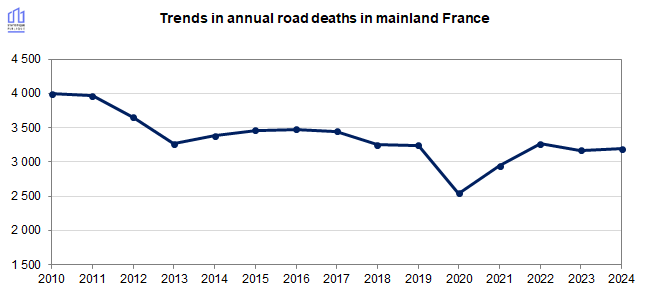
Source: ONISR definitive data up to 2024
Data relating to injury accidents recorded by the police, mainland France
According to the ONISR-Université Gustave Eiffel (Registre du Rhône – Rhône register) estimation method applied to injury accidents recorded by the police in 2024, 235,600 people were injured on the roads of mainland France in 2024, 16,000 of them seriously. The trend in the number of people injured for all types of accident is stable compared with 2023 (+0.3%), as was the number of people seriously injured (-0.1%).
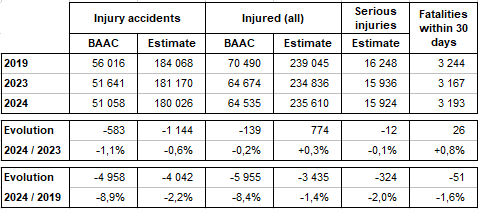
Source: ONISR definitive data up to 2024
Data relating to injury accidents recorded by the police, mainland France
2024 casualties by road networks in mainland France
Roads in rural areas accounted for 60% of deaths and 47% of serious injuries in 2024, and 1,924 people were killed on roads in rural areas (47 more than 2023, i.e. +3%).
In urban areas, 1,030 people were killed (9 more than 2023, i.e. +1%).
On motorways, 239 people were killed (30 fewer than 2023, i.e. -11%).
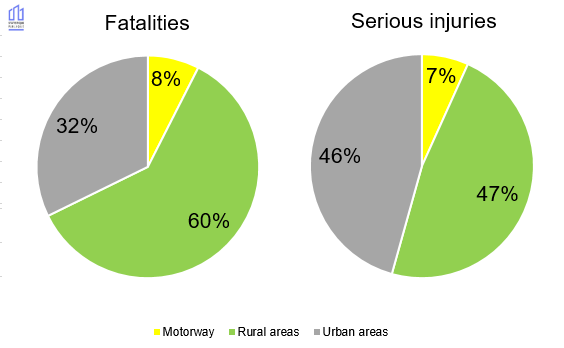
Source: ONISR definitive data up to 2024
Data relating to injury accidents recorded by the police, mainland France, and estimates based on ONISR-Université Gustave Eiffel modelling (Rhône Register).
2024 casualties according to age and gender in mainland France
Fatalities according to gender
In 2024, out of the 3,193 people who died on the roads, 2,465 were men (including 25 boys under the age of 14) and 728 were women (including 21 girls under the age of 14).77% of people killed in road accidents in mainland France are male. Thus, the proportion of men in road deaths remains predominant (77.2% compared to 77.6% in 2023, 77.3% in 2019 and 76.7% in 2018).

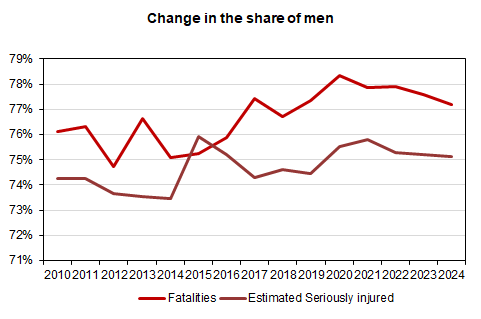
Source: ONISR definitive data up to 2024; Insee – Estimated 2024 population on January 1st.
Data relating to injury accidents recorded by the police, mainland France, and estimates based on ONISR-Université Gustave Eiffel modelling (Rhône Register).
Regardless of the mode of transport, the proportion of men killed is consistently higher than that of women, but varies greatly depending on the mode of transport. In fact, men account for between 61% of those killed when walking, 71% in passenger cars and 94% on motorised two-wheelers. Motorised two-wheelers are the mode of transport with the highest excess male mortality, regardless of the indicator analysed. However, this is to be expected given the low number of women who drive motorised two-wheelers. Conversely, walking and passenger cars are the modes of transport with the most consistent mortality rates between the sexes..

Source: ONISR definitive data up to 2024
Data relating to injury accidents recorded by the police, mainland France
Fatalities according to the age group
In 2024,
- 94 14-17 year-olds were killed, down on 2023 (-22 fatalities) and stable compared with 2019.
- 529 young adults aged 18-24 died, a higher figure than in 2023 (+32 fatalities) but down from 2019 (-20 fatalities); the number of fatalities among 18-24 year olds per million young people of this age remains very high, at 97 per million inhabitants.
- There were 441 deaths among 25-34 year olds, down from 2023 (-24 deaths) and 2019 (-75 deaths).
- There were 400 deaths among 35-44 year olds, higher than in 2023 (+35 deaths) and 2019 (+17 deaths).
- With just under 400 deaths in each of the 45-54 and 55-64 age groups, the toll remained stable in 2024 compared with 2023.
- 365 people aged 65-74 died, stable compared with 2023 but higher than in 2019 (+48 deaths).346 people aged 75-84 died, higher than in 2023 (+8 deaths) and 2019 (+29 deaths).
- 189 people aged 85 or over died, a higher figure than in 2023 (+10 deaths) but lower than in 2019 (-26 deaths).
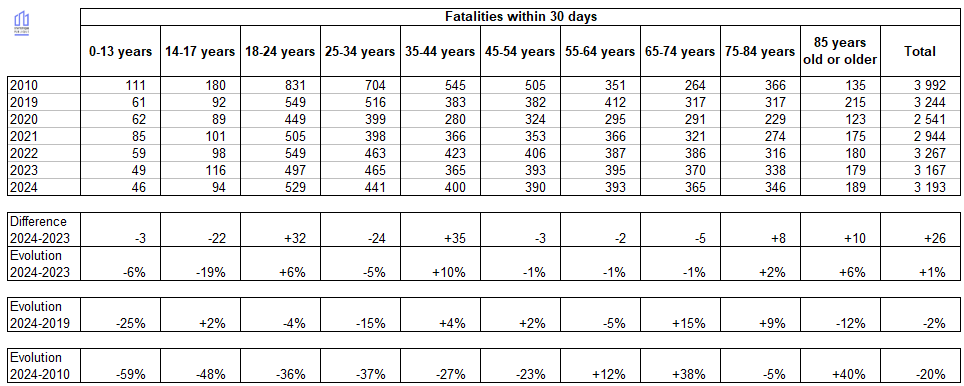
Source: ONISR definitive data up to 2024
Data relating to injury accidents recorded by the police, mainland France
To understand the real change in risk for each age group, it is useful to look at the number of deaths per million inhabitants in each age group. Thus, given the increase in the senior population, the upward trends that often appeared are put into perspective by a downward trend or stability. Young people and teenagers under the age of 18 now have the lowest mortality rates. The greatest progress in terms of deaths has been made among 0-13 year olds (a 59% decrease since 2010). In 2024, 48 people died per million inhabitants in mainland France. The highest rates, indicating the age groups most at risk of dying on the roads, are:
In 2024, 48 people died per million inhabitants in mainland France. The highest rates, indicating the age groups most at risk of road deaths, are:
- 97 deaths per million population for young people aged 18-24 ;
- 84 deaths per million for senior citizens aged 85 or over;
- 74 deaths per million for senior citizens aged 75-84;
- 57 deaths per million for the 25-34 age group.
Serious injuries by age
According to estimates by ONISR-Université Gustave Eiffel (Rhône Register), around 16,000 people were seriously injured in 2024.
48% of serious injuries occur in people under the age of 35:
- 730 children (aged 0-13) were seriously injured, a decrease compared to 2023 (-2%) and 2019 (-8%).
- 1,580 teenagers aged 14-17 were seriously injured, a figure that remained stable compared to 2023 and increased (+6%) compared to 2019.
- 2,790 young adults aged 18-24 were seriously injured, a figure that remained stable compared to 2023 but down compared to 2019 (-1%).
- An estimated 2,440 people aged 25-34 were seriously injured, a decrease compared to 2023 (-1%) and 2019 (-7%).
35% of serious injuries occur among people aged between 35 and 64:
- An estimated 1,900 people aged 35-44 were seriously injured, a decrease compared to 2023 (-1%) and 2019 (-3%).
- An estimated 1,950 people aged 45-54 were seriously injured, a decrease compared to 2023 (-2%) and 2019 (-10%).
- An estimated 1,780 people aged 55-64 were seriously injured, a decrease of -1% compared to 2023 and 2019.
17 % des blessés graves ont 65 ans ou plus :
- 1,400 people aged 65-74 were seriously injured, a higher figure than in 2023 (+2%) and 2019 (+4%).
- 1,000 people aged 75-84 were seriously injured, a higher figure than in 2023 (+10%) and 2019 (+10%).
- 300 people aged 85 or over were seriously injured, a decrease compared to 2023 (-1%) and 2019 (-9%).
People aged 65 or over are less likely to be seriously injured, but their physiological vulnerability means that they rarely survive serious accidents.
It is estimated that nearly 22,300 people will still be suffering from after-effects one year after the accident. People under 35 account for 50% of those injured with after-effects.
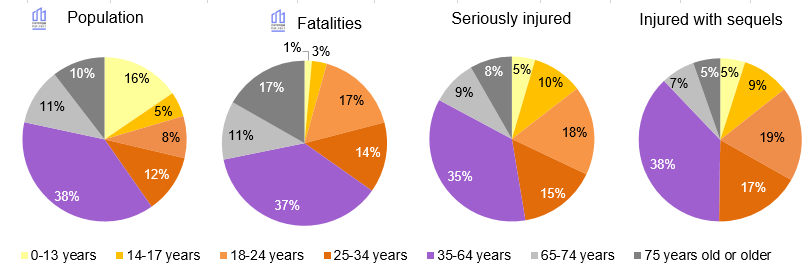
Source: ONISR definitive data up to 2024; Insee – Estimated 2024 population on January 1st.
Data relating to injury accidents recorded by the police, mainland France, and estimates based on ONISR-Université Gustave Eiffel modelling (Rhône Register)
Deceased persons who are not responsible
Of the 3,193 people who died in accidents in 2024, 2,019 were presumed responsible and 1,174 were not presumed responsible.
1,174 people who were not responsible died (63% were men), including 126 where the person presumed responsible also died and 1,028 where the person presumed responsible is still alive. In 20 cases, no person presumed responsible was identified in the accident.
The victims killed who were not presumed responsible break down as follows according to their mode of transport:
- 26% pedestrians
- 8% cyclists
- 1% EDPm
- 16% motorcyclists and 3% motorcycle passengers
- 11% car drivers and 29% car passengers
- 1% light commercial vehicle or heavy goods vehicle drivers, 3% light commercial vehicle or heavy goods vehicle passengers.
Thus, 26% are pedestrians, 29% are vehicle drivers and 34% are vehicle passengers. 54% are vulnerable road users (pedestrians, cyclists, EDPm, 2WVs), both drivers and passengers.
34% of victims killed who were not presumed to be at fault were aged 65 or over: 21% were aged 75 or over. 21% of victims killed were under the age of 25.

Source: ONISR definitive data up to 2024
Data relating to injury accidents recorded by the police, mainland France
2024 casualties according to the mobility mode in mainland France
Since the pandemic, the proportion of vulnerable road users (pedestrians, cyclists, moped users, motorised two-wheelers) among those killed or seriously injured has increased.
Passenger car occupants now account for less than half of those killed (48%).
The proportion of powered two-wheeler (P2W) users is increasing: they account for 23% of those killed, 32% of those seriously injured and 36% of those injured who will suffer after-effects 1 year after the accident, for less than 2% of motorised traffic.
The proportion of cyclists and PMDs motorized users is increasing: they account for 8% of fatalities, 21% of those seriously injured and 32% of those injured with serious after-effects 1 year after the accident.

Source: ONISR definitive data up to 2024; SDES – Individuals’ mobility survey (Enquête mobilité des personnes) 2019.
Data relating to injury accidents recorded by the police, mainland France, and estimates based on ONISR-Université Gustave Eiffel modelling (Rhône Register).
In 2024, it is estimated that 1,518 occupants of passenger cars died, 720 P2W users, 456 pedestrians, 224 cyclists and 45 PMDs motorized users, 120 occupants of commercial vehicles, 30 occupants of heavy goods vehicles, 34 occupants of microcars (small cars that can be driven with an AM licence), and 7 occupants of coaches or buses. Among other vehicles, 19 were quad bikes, 12 were agricultural tractors, and 4 were specialised construction vehicles.
The number of people killed in 2024 is higher than in 2023 (+0.8%, or +26 fatalities) and lower than in 2019 (-1.6%).
The increase is largely due to higher mortality rates among pedestrians (+17 fatalities compared to 2023, -27 fatalities compared to 2019) and motorcyclists (+14 fatalities compared to 2023, -29 fatalities compared to 2019).
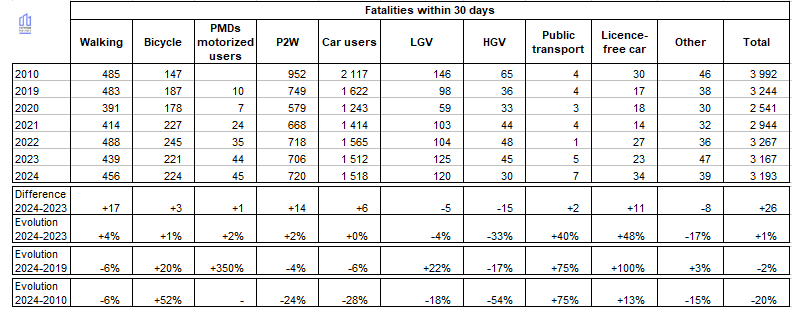
Source: ONISR definitive data up to 2024.
Data relating to injury accidents recorded by the police, mainland France
Road safety results overseas
In this chapter, the results concerning injury accidents, fatalities and injured people correspond to the definitive data as recorded by the police in the BAAC file. The ONISR-Université Gustave Eiffel (Rhône register) methodology for estimating injuries is not currently applied to the French overseas territories.
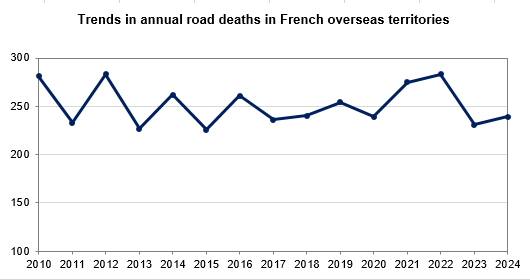
Source: ONISR definitive data up to 2024.
Data relating to accidents involving injuries recorded by the police in the French overseas territories
239 people were killed on the roads in the French overseas territories in 2024, 160 in the overseas counties and 79 in the overseas collectivities and New Caledonia (NC). This represents an increase of +3% (or 8 more fatalities) compared to 2023 and a decrease of -6% (or 15 lower fatalities) compared to 2019 (reference year).
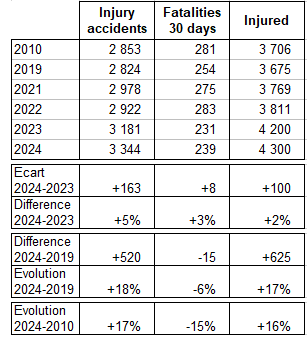
Source: ONISR definitive data up to 2024.
Data relating to accidents involving injuries recorded by the police in the French overseas territories

Source: ONISR definitive data up to 2024.
Data relating to accidents involving injuries recorded by the police in the French overseas territories
In 2024, car accidents accounted for more than a third of road deaths in overseas territories, with 86 fatalities. Seat belts are a major issue in overseas territories, where more than half of those killed in passenger cars, commercial vehicles or heavy goods vehicles were not wearing a seat belt.
Motorcycle fatalities, with 83 users killed, will increase in 2024 compared to 2023 (+11 fatalities), accounting for more than a third of road deaths in overseas territories. Not wearing a helmet accounts for more than one in four deaths on motorised two-wheelers.
Pedestrian deaths, with 45 pedestrians killed, will increase in 2024 compared to 2023 (+6 deaths) but will decrease compared to 2019 (-8 deaths).
Road deaths among young people aged 18-24 are up compared to 2023 and stable compared to 2019: 47 killed in 2024 compared to 34 killed in 2023 and 49 killed in 2019. Twenty-six young adults were killed in 2024 in the French overseas departments and regions, compared with nine last year and an average of 28 over the last five years.
The mortality rate for 25-44 year olds is stable compared to 2023 and up compared to 2019: 88 killed in 2024, 88 also in 2023 and 86 killed in 2019.
The mortality rate for 45-64 year olds is up compared to 2023 and down compared to 2019: 59 killed in 2024 compared to 57 killed in 2023 and 68 killed in 2019.
The mortality rate for senior citizens aged 65 and over is down compared to 2023 and up compared to 2019: 32 killed in 2024 compared to 38 killed in 2023 and 28 in 2019. Senior citizens remain much less represented than in mainland France.
The road risk varies greatly according to the territory
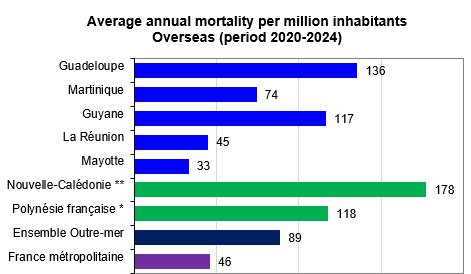
Source: ONISR definitive data up to 2024.
Data relating to accidents involving injuries recorded by the police in the French overseas territories
The breakdown of deaths by mode of transport reveals significant regional differences.
While the average proportion of deaths involving motorcycles is 23% across overseas territories, 4 points higher than in mainland France,
- this ratio is lowest in New Caledonia (7%) and French Guiana (14%);
- and more than double that of overseas territories in Martinique.
- The average proportion of deaths involving mopeds is more than double that of overseas territories as a whole (10%) in French Guiana (23%) and French Polynesia (26%).
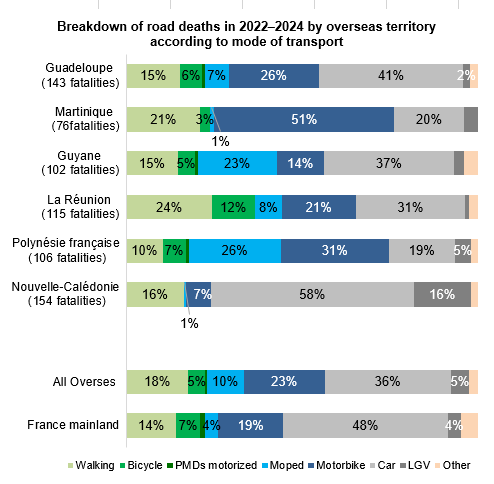
Source: ONISR definitive data up to 2024.
Data relating to accidents involving injuries recorded by the police in the French overseas territories
In overseas counties
Road deaths are on the rise in the French overseas departments and regions. It rises from 135 fatalities in 2023 to 160 in 2024 (135 men and 25 women), representing an increase of 25 deaths. This is a decrease compared to 2019 (2 fewer deaths).
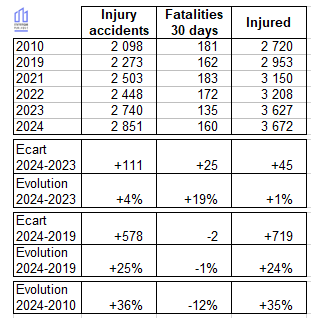
Source: ONISR definitive data up to 2024.
Data relating to accidents involving injuries recorded by the police in the French overseas counties
In overseas communities and New Caledonia
The mortality rate in overseas communities and New Caledonia was 79 deaths in 2024 (63 men and 16 women). This is down from 2023 (17 fewer deaths) and 2019 (13 fewer deaths).

Source: ONISR definitive data up to 2024.
Data relating to accidents involving injuries recorded by the police in the French overseas communities and New Caledonia

